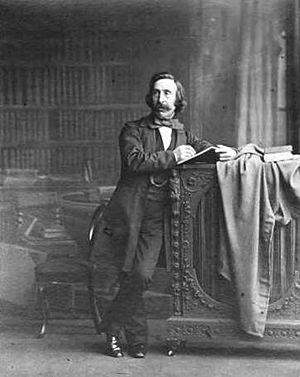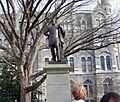John Henry Foley facts for kids
Quick facts for kids
John Henry Foley
|
|
|---|---|

John Henry Foley in 1863, by Ernest Edwards
|
|
| Born | 24 May 1818 Dublin, Ireland
|
| Died | 27 August 1874 (aged 56) Hampstead, London
|
| Resting place | St. Paul's Cathedral, London |
| Nationality | Irish |
| Alma mater | Royal Academy Schools |
| Known for | Sculpture |
John Henry Foley (born May 24, 1818 – died August 27, 1874) was a famous Irish sculptor. He worked in London and created many important statues. He is especially known for his statues of Daniel O'Connell in Dublin and Prince Albert for the Albert Memorial in London.
Contents
The Life of a Sculptor
John Henry Foley was born in Dublin, Ireland, on May 24, 1818. His father was a glass-blower, and his step-grandfather was also a sculptor. When he was 13, John began studying drawing and sculpting at the Royal Dublin Society. He won many top awards there.
In 1835, he moved to London to study at the Royal Academy Schools. He first showed his art at the Royal Academy in 1839. He became well-known in 1844 with his sculpture called Youth at a Stream. After this, he received many requests for new sculptures, which kept him busy for the rest of his life. He became a full member of the Royal Academy of Art in 1858.
In 1851, the city of London decided to spend a lot of money on sculptures for a building called the Mansion House. Foley was asked to create two sculptures: Caractacus and Egeria.
In 1864, Foley was chosen to sculpt one of four large stone groups for the Albert Memorial in London. These groups represented different continents. His design for Asia was approved that year. Later, in 1868, he was also asked to create the bronze statue of Prince Albert himself for the center of the memorial. This happened after another sculptor, Carlo Marochetti, had trouble finishing the statue.
Foley showed his work at the Royal Academy from 1839 to 1861. Some of his other works were shown after he passed away in 1875.
John Henry Foley died at his home in Hampstead, London, on August 27, 1874. He was buried in the crypt of St. Paul's Cathedral. He left his sculpture models to the Royal Dublin Society, where he first learned art. He also left much of his money to a fund that helps artists. He did not live to see the Albert Memorial finished. There is a statue of Foley himself on the front of the Victoria and Albert Museum.
Foley's Students
John Henry Foley taught many students who became sculptors themselves. One of his students, Thomas Brock, finished several of Foley's sculptures after he died. This included the statue of Prince Albert for the Albert Memorial.
Another student, Francis John Williamson, became a very successful sculptor. It is said that Queen Victoria liked his work best. Other students who learned from Foley included Charles Bell Birch, Samuel Ferris Lynn, Charles Lawes, and Richard Belt.
Works Removed in Ireland
After Ireland became independent in 1922, some of Foley's statues were removed or destroyed. This happened because the people shown in these statues were seen as symbols of the old government. For example, statues of Lord Carlisle, Lord Dunkellin, and Field Marshal Gough were taken down. The statue of Lord Dunkellin in Galway was damaged and removed.
Gallery
-
Daniel O'Connell on O'Connell Street, Dublin
-
Michael Faraday in London
-
Prince Albert in the Albert Memorial, Hyde Park
-
Stonewall Jackson in Richmond, Virginia
-
Statue of Father Mathew in St. Patrick's Street, Cork
-
Statue of Benjamin Guinness at St Patrick's Cathedral, Dublin
-
The statue of Lord Carlisle, which stood in the Phoenix Park, Dublin, from 1870 to 1956
-
Statue of Sir James Outram at Maidan, now in garden of Victoria Memorial, Kolkata, India
Famous Sculptures by Foley
Here are some of the well-known sculptures created by John Henry Foley:
In London
- Egeria (1856) and Caractacus (1857), for the Mansion House.
- The Elder Brother from Comus (1860), a work he made for the Royal Academy.
- The Muse of Painting (1866), a monument for artist James Ward.
- John Hampden (1847) and John Selden (1853) for the Palace of Westminster.
- Seated marble statue of Charles Barry (1863) in the Palace of Westminster.
- Sir Joshua Reynolds, a marble statue, in the Tate Gallery collection.
- The group representing Asia, and the statue of Prince Albert himself, for the Albert Memorial.
- Michael Faraday, a marble statue, for the Royal Institution. Thomas Brock finished this statue after Foley's death.
- Marble bust of William Hookham Carpenter in the British Museum.
In Ireland
- Oliver Goldsmith (1864) and Edmund Burke (1868), outside Trinity College, Dublin.
- Daniel O'Connell (1866–74), on O'Connell Street, Dublin.
- Sir BL Guinness (1875), Dublin.
- Field Marshal Gough, formerly in the Phoenix Park, Dublin, now at Chillingham Castle.
- Henry Grattan, College Green, Dublin.
- Sir Dominic Corrigan (1869), a marble statue, at the Royal College of Surgeons, Dublin.
- Ulick de Burgh, Lord Dunkellin (1873), Eyre Square, Galway.
- Memorial to Brigadier General John Nicholson (1862), Lisburn Cathedral.
- Memorial to Father Mathew, a campaigner for teetotalism (1864), Cork.
In Other Places
- Statue for George Howard, the 7th Earl of Carlisle (1869), in Brampton, Cumbria.
- Hermaphroditus or Youth at the stream (1844), a bronze statue now in Bancroft Gardens in Stratford-upon-Avon.
- Lord Clyde (1868), Glasgow.
- Clive, Shrewsbury.
- Viscount Hardinge (1857), an equestrian statue (showing a person on horseback), originally for Calcutta.
- Canning (1874) for Calcutta. This bronze equestrian statue was finished by Thomas Brock after Foley's death.
- Sir James Outram (1864), for Calcutta.
- Memorial to the lawyer James Stuart (1854) for Colombo, Ceylon (now Sri Lanka).
- Stonewall Jackson, Richmond, Virginia.
- John Fielden (1869), Centre Vale Park, Todmorden.
Images for kids
See also
- List of public art in the City of London
- List of public art in Dublin
- List of public art in Cork














